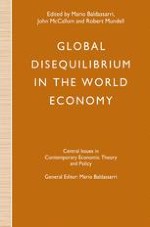1992 | OriginalPaper | Buchkapitel
The Global Adjustment System
verfasst von : Robert A. Mundell
Erschienen in: Global Disequilibrium in the World Economy
Verlag: Palgrave Macmillan UK
Enthalten in: Professional Book Archive
Aktivieren Sie unsere intelligente Suche, um passende Fachinhalte oder Patente zu finden.
Wählen Sie Textabschnitte aus um mit Künstlicher Intelligenz passenden Patente zu finden. powered by
Markieren Sie Textabschnitte, um KI-gestützt weitere passende Inhalte zu finden. powered by
The international monetary system that came into prominence in the four decades before World War I was a system for regulating money supplies and stabilizing, within small margins, exchange rates. It was called the gold standard because already in 1880, but especially by 1900, the currencies of the major world powers were convertible into gold. But the international monetary system was by no means monolithic. Besides the gold bloc, there were countries on the silver standard and a few countries with inconvertible paper currencies. The gold bloc itself embraced many different monetary forms; each national monetary system was unique. Many countries were in the gold currency area but did not have a gold currency; their currencies were merely convertible into gold currencies, as in the gold exchange standard (1). It is nevertheless true that the gold standard, especially between 1900 and 1913, did give the world a kind of monetary unity, covering over two thirds of the world’s monetary transactions. The gold bloc was a currency area of fixed exchange rates, that could be called, after Gustav Cassel, a world-wide sterling area, because of the global importance of sterling as a unit of account, the transactions domain of the British Empire and London as the centre of the international capital market (2).
